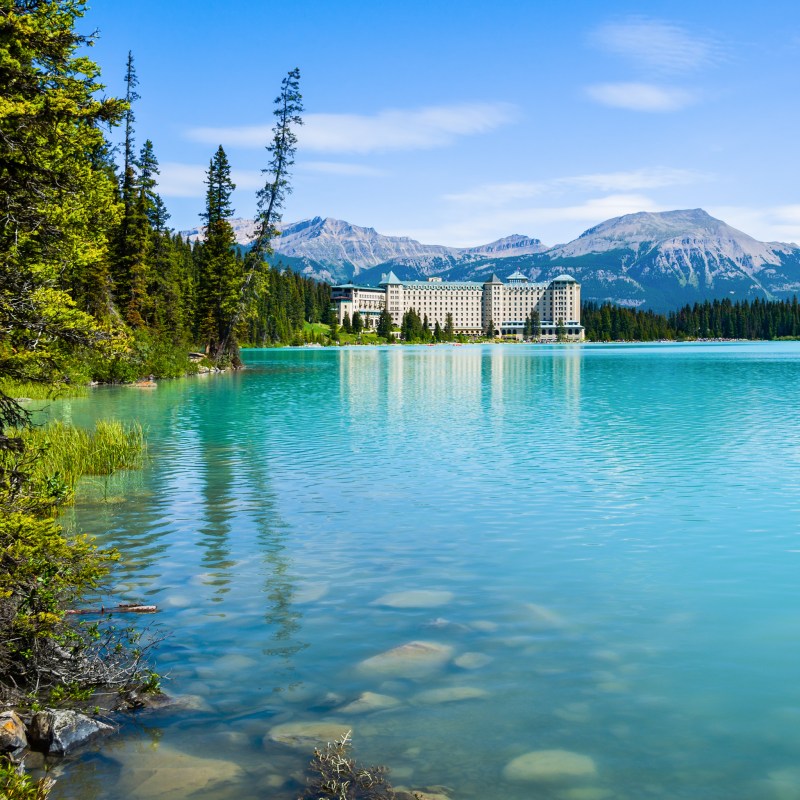
Lake Louise in the Canadian Rockies is famously beautiful. It’s a must-visit place, thanks to the turquoise water and the sharp-edge mountains on all sides. From May to October, though, it’s becoming a must-avoid place because of overcrowding here and at nearby Moraine Lake.
Videos by TravelAwaits
Here are a few tips to make the most of your trip, crowds or no crowds.
1. Take Parks Canada’s Advice For When To Visit
Parks Canada’s information about the best and worst times to visit gives specific tips on how to get here, all intending to manage the traffic. It’s essential reading for planning the trip.
I live about two hours away. Unless I can stay within a short walk of the lake, I avoid it in the summer. I’ll visit in winter and shoulder season, and in summer I’m happy to go to other lakes instead.

2. Weighing The Pros And Cons (And Packing Right) Is Essential
Lake Louise is an awe-inspiring, naturally beautiful spot that has inspired travelers and artists for generations. The mountains tower, the glaciers gleam, the lake glistens, and everything is picturesque.
It’s accessible by car.
There’s lots to do, including canoeing, walking and hiking, and, in winter, skiing, skating, and taking a sleigh or dogsled ride.
The only negatives are the crowds and the impossibility of promising great weather every single day. To deal with the weather, dress in layers, and always have warm clothing handy, even in summer. Wear waterproof walking shoes or hiking boots if you want to spend time exploring.
As far as the crowds go, after a bit of background information, I’ll offer points to consider when making plans. Also, I will explain how Lake Louise was formed, and suggest some other gorgeous lakes.
3. Located Inside Banff National Park
Canada’s first national park is vast, mountainous, and mainly wild. Banff National Park is part of the Canadian Rocky Mountain Parks, a UNESCO World Heritage Site.
You need a parks pass from Parks Canada to visit.

4. Lake Louise Is A Lake, A Town, And A Ski Hill
The actual lake is 4.4 km (2.7 miles) uphill from the Trans-Canada Highway interchange, about 40 minutes west of Banff.
Lake Louise is also a small town with a pleasant range of services and shops in the Samson Mall. The travel center features displays about the animals and landscape and up-to-date information.
Lake Louise Ski Resort is 7 km (4.3 miles) from the lake. There, you can enjoy an expansive view from the Summer Sightseeing Gondola.
5. The Lake’s Namesake Was A Princess
Princess Louise Caroline Alberta, born in 1848 was the sixth of Queen Victoria’s nine children.

6. History Of The Fairmont Chateau Lake Louise
The Fairmont Chateau Lake Louise has 539 rooms. But modern development inside Banff National Park is heavily regulated and limited. How did a luxury hotel get here?
The Canadian Pacific Railroad (CPR) built the Chateau starting in 1890 to entice wealthy guests to use the train. Rail travel is rare in Canada now, but the great hotels live on.
Lake Louise is stunning (here’s a webcam view) but it’s not the only accessible, beautiful lake in the Rockies. The marketing efforts of the CPR put Lake Louise on the map of the world’s great tourist destinations.
7. The Chateau Offers More Than A Place To Stay
The Fairmont Chateau Lake Louise has restaurants, bars, shops, a spa, lovely grounds, and sports equipment rentals.
Guests come first, but many of the Chateau’s facilities are open to the public.
There are other hotels and hostels here and in Banff.

8. Winter Vs. Summer
Each season offers different things to do in Lake Louise.
In winter, the turquoise lake freezes and snow covers the ice, turning it white. This creates an opportunity for the ultimate ice skating experience, and the lake is still very photogenic.
The average daily temperatures are highest in July and August (highs of 20 degrees Celcius, 69 Fahrenheit; lows of 3 Celcius, 38 Fahrenheit) and lowest in December and January (highs of -8 Celcius, 18 Fahrenheit; low of -20 Celcius, -6 Fahrenheit).
The weather can change suddenly.
The summer days have more than eight hours of extra sunlight than winter days. In June, the sun is up from 5:27 a.m. until 10:05 p.m. In December, it’s 8:47 a.m. till 4:47 p.m.
Winter nights are great for stargazing and maybe seeing the Northern Lights.
Many animals and birds are seasonal. Some, like the rufous hummingbird, migrate south for winter. Bears hibernate in the winter and wake up hungry in the spring. Some animals are active year-round. Depending on when you go, you may see them or spot their tracks in the snow.
9. Winter Means More Than Skating
Yes, Lake Louise freezes to a safe thickness from about December through March, and the Chateau staff clear maintains rinks for skating and hockey, with floodlights that turn off at 11 p.m. Bring your own skates or rent some at Chateau Ski and Snow.
Each winter, there’s also a crystal ice castle and ice sculptures are a captivating sight. In January, the Ice Magic International Carving Competition shows what artists can create from this challenging material.
Downhill skiers and snowboarders stay at Lake Louise because it’s close to the hill. You can cross-country ski or snowshoe across the lake, or start lower down and climb through the woods to the Chateau on the marked trails.
Kingmik Dog Sled Tours runs tours nearby.
The Rockies can be spectacular in winter when the sky is blue and the snow gleams. Prepare for lots of photo opportunities!
10. The Shoulder Season Deserves Your Attention
With Parks Canada warning of heavy traffic from May to October, it’s getting harder to say there is a true shoulder season right at the lake, even though for tourism in the park generally, there is a lull in spring and fall.
In March, the Lake Louise area is likely to still be quite snowy. In April and May as the snow and ice melt, hiking season begins. It starts with the lakeshore trail, and by about June, trails leading to higher elevations become passable. The fall season doesn’t have this problem — the snow is yet to arrive.
The tea houses at Lake Agnes and the Plain of Six Glaciers, open from about June to mid-October, are popular day hikes.
The Icefields Parkway to Jasper starts at Lake Louise. In the fall, the highway is open but the businesses along it close until spring. This includes the gas station and the Icefield Centre. By visiting early or late in the operating season of the Icefield Centre, you can avoid the worst of the summer rush at Lake Louise.

11. Summer Has Its Charms (Despite The Crowds)
Summer is when crowds really are a problem. It’s a shame, because the lake itself looks fantastic, just like in pictures.
The main problem is cars and parking. The crowds tend to stay fairly close to the Chateau.
One solution is to stay overnight at the Chateau or Deer Lodge, or in Lake Louise Village. From there, it’s about an hour uphill walk or a short shuttle bus ride to the lake. Biking may be possible via a trail rather than the road, for safety.
RVs and vehicles pulling trailers may find it challenging. Take a bus instead.
Despite the crowds, the appeal of Lake Louise in the summertime is still the gorgeous views, which brings us to the Lake Louise landscape.
12. Geological Wonder
Lake Louise is a rectangular, natural lake about 2 km (1.2 miles) long and 0.5 km (0.3 miles) wide. At one end, the fairy-tale Chateau Lake Louise sits on a low hill. At the other, Mount Victoria and the Victoria Glacier create the postcard-perfect backdrop.
Mountains encircle the lake, which gets its famous turquoise color from the fine rock particles suspended in the water. The rock particles are created by the glacier grinding the mountain bedrock.
All these features are clues to how Lake Louise was formed.
At its largest, the glacier reached the site of the Chateau. Glaciers are sheets of ice with a lot of rocks and gravel hitching a ride. These fall onto the ground when the glacier melts. That’s what made the Chateau’s hill.
The glacier carved a hollow in the valley, creating a small glacial lake, called a tarn. Tarns sit in bowls called cirques, high up the mountainsides. Many have a glacier overhead.
You don’t get many opportunities to drive so close to a glacial lake, but Lake Louise isn’t the only one.

13. Nearby Mountain Lakes
I’ll admit that these alternatives to Lake Louise are also popular in summer, but none are as crowded as Lake Louise is during peak season.
On the Icefields Parkway, consider the larger Bow Lake, or Peyto or Hector Lake. Further west on the Trans-Canada Highway, Emerald Lake in Yoho National Park is another glacial lake famous for its color.
For hikers, the choices open up even more. The Canadian Rockies Trail Guide, available from Summerthought Publishing in print and electronically, is a great guidebook that can help you navigate to mountain lakes you otherwise might never consider.
Pro Tips
Please don’t let me discourage you. Lake Louise is truly lovely, but you need a plan ahead. In summer the parking lot fills up before sunrise! Consider what kind of Lake Louise vacation experience you want to have, and check with Parks Canada for their current Lake Louise visitor advice.
